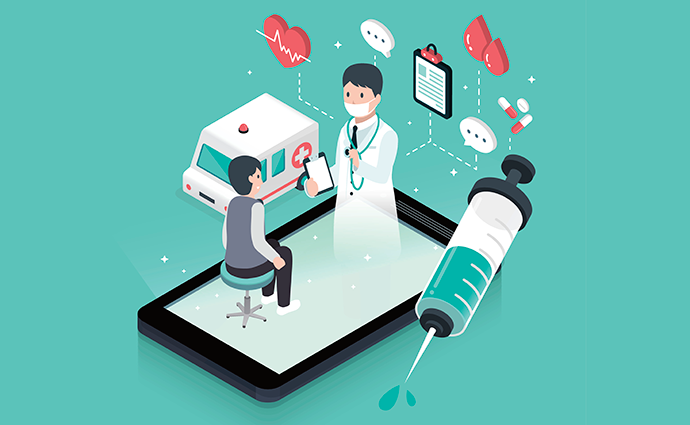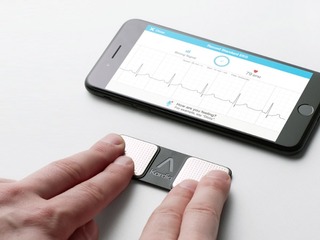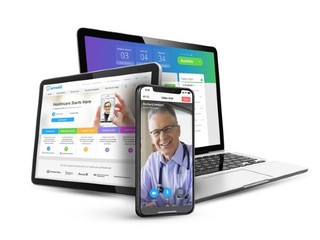Advancing toward a brain on a chip: addressing the need to find therapeutics that work
The webinar included representatives from ACRO Biosystems, Bristol Myers Squibb, and eNuvio
Read more...
The immediate effect of COVID-19 on the healthcare system was that it pushed care much closer to where the patient already is, meaning their home. That trend was already happening, with telehealth and digital assessment tools, but the fear of seeing a doctor in person has accelerated it far beyond what was expected at this stage. Almost overnight these tools went from a "nice to have" to " have to have."
In many ways, that will be a positive change for both the patient and the physician, according to a panel of healthcare experts at Vator and HP's Future of Virtual Care event on Wednesday
Moderated by Archana Dubey (Global Medical Director, HP) and Bambi Francisco Roizen (Founder & CEO, Vator), the panel featured Dr. Peter Antall (Chief Medical Officer, Amwell), Priya Abani (CEO, AliveCor), Ann Mond Johnson (CEO, American Telemedicine Association) and Sunny Kumar (Partner, GSR Ventures).
The topic of remote patient monitoring came up when Dubey asked Johnson if she saw that value-based dollars could be tied into increased adoption. Basically, can things like virtual care and remote patient monitoring be integrated into the patient care model?
Johnson's response: "Absolutely."
"Pre-COVID, what was clear was that telehealth did okay in a fee-for-service environment or cash only environment, but it soared in a value-based environment," she said, noting that what the American Telemedicine Association is advocating for now is "that telehealth is really acknowledged as health, and as a modality of care."
"It's never going to replace everything that's done in-person, but it certainly has a legitimate role. We saw it not just with the synchronous communication, the audio and video, or the audio only, but we also saw with the asynchronous, the ability for chat forward or interactive assessments to really help the delivery systems and physician practices scale their response."
Johnson also called remote monitoring "a complete unsung hero in all of this," mentioning organizations like Livongo, "who have done an amazing job with remote monitoring, recognizing that you don't want people to go to places where they're exposed unnecessarily to danger or to infection."
"People want to stay home. I mean, in a time like this, yeah, sure, parts of the country are going a little bit crazy now, but they want to stay home and they want to be able to be taken care of at home. So, I think remote monitoring is just astonishing."
Dubey then asked Kumar what he saw in the virtual care space pre-COVID and how it now affecting the portfolio at GSR Ventures. His response was that, "There's been a massive change in behavior."
"That's been a significant driver of the adoption that we're seeing across the board, across a number of different dimensions. Many of my physician colleagues simply didn't use telemedicine before, it was a small minority of physicians that were truly virtually enabled, ready to go in the pre-COVID world and when COVID hit, everybody had to switch, had to be able to be virtually enabled, if you were going to continue to see patients at anywhere close to the previous volumes that you were delivering."
The main issue in getting care right now, Kumar said, is transportation and actually getting to the doctor, especially if you need public transportation. The other major issue is a lack of doctors, so anything that makes them the physician efficient, such as remote monitoring, is a big focus for the firm right now.
"At the end of the day, we have to find a way to make those physicians much more efficient and able to deliver care across a broader swath of the population. And that's what gets us really excited. We look at companies that are developing solutions that can make physicians more efficient by delivering virtual care, so not just a one-to-one replacement of a video visit with in-person visit, but allowing that physician to deliver that care over the same amount of time to 2x, 3x 10x the number of patients. That's how we really believe you're going to bend the cost curve and really solve underlying access issues, whether it be across primary care, mental health, and a number of other issues," he said.
"The post-COVID world should be one in which we have made physicians not only able to reach a broader number of patients, but also made them much more efficient in being able to do so."
Francisco then turned to Antall and asked him what possibilities he is seeing in virtual care, and, specifically, which services are staying within the virtual care space, instead of moving to traditional care.
Antall began his answer by referring back to what Kumar said about aiding physicians.
"We talk about things that make providers more efficient, working at the top of their license, using other provider levels, but there's everything from documentation support to crunching and understanding data on the patient that occurs outside of visits," he said, while also mentioning some of the technologies that have allowed asynchronous visits to flourish.
"One thing we saw accelerate very rapidly during COVID was the use of chatbots. Everyone and anyone seemed to have a COVID chatbot screener all of a sudden, within a few weeks, and we're bullish about chatbots, we use chatbots in our waiting rooms as a way to engage the patient and a way to gather data for the visit. It helps with documentation support, for example, it helps to screen out for certain things. We're very bullish in that area, either as standalone interactions or also integrated into the provider flow."
The other benefit of remote monitoring, Antall mentioned, the ability to remind, or nudge, patients to take their medications and adhere to their regimens.
"Outside of visit nudging is going to be a really hot topic for these next few years because we can all tell a patient, we're all providers, we can all tell them what we recommend or prescribe them, what we they should be on," he said.
"But if it's a diabetic, and we prescribe them a second medication because they're poorly controlled, and we see them back in follow up three months later, and we find that they took it for two days and didn't like the way they felt so they stopped it, we just lost three months there and now their A1C might even be higher. And so nudges, interactions outside of visits, there's just so much meat there in improving compliance and improving overall care."
Dubey agreed, mentioning a study done by Kaiser that showed nudges to be an effective tool for smoking cessation, which then became the industry standard.
"It can be scaled now in the virtual cares scenario quite a bit," she said.
"We can all do better. Our traditional mode of healthcare is: you come in and make that appointment, you sit with a physician, or other provider, for X amount of time and then you don't come back for six months or a year," said Antal.
"With our abilities with data, our abilities with algorithms, our abilities with chatbots, healthcare is moving towards a place where providers are encouraged to think algorithmically anyways, that's what chatbots do best, and they do it without a bad day or a bad mood. They can be trained to have empathy, they can bring data in from other settings and integrate that into the conversation. It's just there, it's just a really exciting time."
Later on in the event, one of the members of the audience followed up on this point and asked the panelists to further clarify how these types of technologies
"It seems like virtual care really opens up a lot of options; as you were saying, nudges and tracking behaviors outside of visits, and I just to hear a little bit more about examples of how those out of visit modalities of care get integrated, even within the visit. Again, talking about provider adoption, whether there's barriers there. Just any examples, case studies, anything that comes to mind around those," she asked.
Antall answered first, noting that "we're still stuck in interoperability with EMRs" and called these new technologies "interoperability on steroids."
"Bringing in data here and bringing in data there from different settings, applying algorithms to the data, deciding what's relevant to put in front of the provider and what to not. I think it's a brave new world, to be honest, and I think there's going to be a lot of disruption here. Unfortunately, there's also a lot of fragmentation and that's where we should be focused," he said.
"Who owns it? Does the hospital system own it and they bring in certain vendors to bring their patient's data into the visit, but then you even have the device manufacturers and all of that. We're looking at this, we're trying to play a meaningful role here without being a disintermediaor, or a fragmentor. We're trying to find ways to add value."
To that end, Amwell is working with companies like Livongo in an effort to combine efforts to provide support for patients with certain conditions.
"That's separate from the medical home and we don't want to disintermediate that relationship. So, it's very, very challenging right now. It's exciting as well; there's an amazing opportunity here, but finding out a way to make it seamless and make it user friendly on the patient and provider side I think is the trick."
Abani followed, speaking from her experience as the CEO of a medical device company.
"From our point of view, from the device manufacturer's point of view, we also are looking to create partnerships that have improve access to care. And it also means data, and in many cases personalized data. We're a strong believer in the platform solution versus monolithic technology," she said.
"The kinds of problems that we are trying to solve, in order to drive scale, and also affordability and usability, we will need several cross institution, and maybe even cross industry, collaboration."
With Alivecore, if a patient uses a cardio device, they get a reading from that EKG in 30 seconds, which then they immediately sent to their physician for review. There are multiple places, Abani said, where different technologies can be added to that experience, from when the customer takes the EKG to to how it shows up on the physician dashboard.
"There's a number of first party integrations, third party integrations, there are so many combinations and fragmentation here, but nudging the customer to be more aware of their health, and when do they use a particular device to take a particular measurement, going all the way to what helps the physician in deciding what are the top 10 patients they can see that day, all of these places provide an opportunity for innovation."
While noting that she did not "have a specific answer on how a nudge or a chatbot can help," Abani also said that "all of these places are places that we can innovate with different kinds of technologies."
Kumar followed up, saying that "nudges present such an amazing healthcare opportunity."
"Just to drill down into how transformative this could be, the average adult in America currently sees the doctor, goes to a healthcare visit, roughly three to four times a year. So that means 360 days a year they're not interacting with the healthcare system in any meaningful way. Nudges provides an opportunity to close that gap significantly. But the real question is how do you do that and how do you do that effectively?," he said.
In particular, Kumar noted that remote patient monitoring is one subset of nudging that is "a really interesting area, because, unlike telemedicine, in my opinion, it's one where not only is the funding and reimbursement not lagging, the ability to provide service, but it actually ran ahead.
"The challenge from a healthcare systems perspective is, how do we actually get value out of that remote patient monitoring and how do we integrate that as, Peter mentioned, into your broader healthcare purview? That's a problem that we haven't solved yet today. There's so many different places where you can add value, for example, in hypertension, regular monitoring of blood pressure, and using that to follow up with a patient outside of just your scheduled visits is such low hanging fruit, but we haven't yet seen an opportunity to scale that up."
Kumar specifically mentioned COVID, where, if a patient get a patient gets a positive test back, there are steps they can take to make sure they limit the chance of spreading it, but there's no real follow-up for most patients. Technology can play a role in closing that gap he said, because while there aren't enough doctors to staff all of those calls, but if technology can serve most of those patient, "we could see a way to actually scale that up and have that big impact, making sure that you can have access to health care much more frequently, at a much higher quality than it's currently available today."
Thanks to our sponsors: UCSF Health Hub, HP, Avison Young, Advsr, Scrubbed, Alchemist Accelerator and Stratpoint.
(Image source: healthitsecurity.com)
The webinar included representatives from ACRO Biosystems, Bristol Myers Squibb, and eNuvio
Read more...At Invent Health, healthcare execs and investors discuss why infertility rates are so high
Read more...The panel included Genoscience, Emmeline Ventures, Suncoast Ventures, Wisp, and GENESIS Fertility
Read more...
Joined Vator on
Founder and CEO of Vator, a media and research firm for entrepreneurs and investors; Managing Director of Vator Health Fund; Co-Founder of Invent Health; Author and award-winning journalist.
Joined Vator on
Global Medical Director, Hewlett-Packard Enterprises

